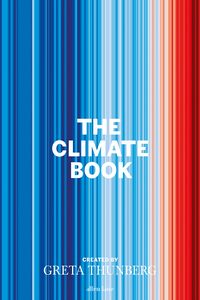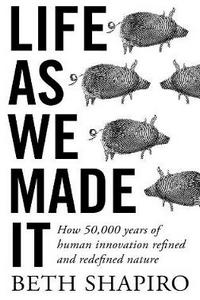Book reviews – Thunberg / Shapiro / Shanahan & Kurti
Climate understanding
 The Climate Book. By Greta Thunberg (author and narrator), Nicholas Khan (narrator), Olivia Forrest (narrator), Amelia Stubberfield (narrator). Penguin Audio . 2022
The Climate Book. By Greta Thunberg (author and narrator), Nicholas Khan (narrator), Olivia Forrest (narrator), Amelia Stubberfield (narrator). Penguin Audio . 2022
It has been five years since a shy 15-year-old Greta Thunberg stepped on to the global stage by spending her Fridays holding up a sign reading ‘Skolstrejk för klimatet’ (School Strike for Climate) outside the Swedish Parliament, calling for stronger action on climate change and battling the forces of climate inaction and denial. During this time, she has written three books including this, her most recent offering, which she has produced and narrated alongside other activists such as Nicholas Khan, Olivia Forrest, and Amelia Stubberfield. With contributions from over one hundred experts, including geophysicists, oceanographers, and meteorologists; engineers, economists, and mathematicians; historians, philosophers, and indigenous leaders, to equip us all with the knowledge we need to combat climate disaster. Alongside them, she shares her own stories of demonstrating and uncovering greenwashing around the world, revealing how much we have been kept in the dark and frequently misled by the powers that be.
For some time now I have been looking for the type of environmental book that could give me a reasonably good and broad understanding of climate change, including its causes, effects, and what needs to be done to stabilise and hopefully one day reverse it. A book that is factual, easily understood and not too demanding on my mental health in terms of the emotions and melancholy that are all too often triggered by the crazy social system in which we live. Well, I am pleased to say that The Climate Book pretty much delivered in all the above. Beautifully written and narrated with great passion and emphasis when needed (a particular advantage of an audio book) it really brought home all the chaos and destruction that has been inflicted upon the environment and Planet Earth, which the author blames squarely on the productive processes that created the industrial revolution and modern-day capitalism. A common denominator that brings out the overall theme of the book, with every one of the 100+ contributors arriving at virtually identical conclusions is the insatiable appetite for profit taking precedence over the welfare of the planet and its inhabitants, including flora and fauna.
My only criticism is when she describes how every ‘ism’ including conservatism, liberalism, labourism and – you guessed it – communism and socialism has failed to offer any proper solution to mitigate the ongoing challenges of pollution and its effects on the climate. Meaning that this otherwise intelligent and admirable young woman still has a little bit to learn about the politics of the subject matter. Nothing wrong, though, with her closing statement … ‘Once we are given the full picture, how can we not act? And if a schoolchild’s strike could ignite a global protest, what could we do collectively if we tried? We are alive at the most decisive time in the history of humanity. Together, we can do the seemingly impossible. But it has to be us, and it has to be now.’
PAUL EDWARDS
Humans and Nature
 Life As We Made It. How 50,000 Years of Human Innovation Refined – and Redefined – Nature. By Beth Shapiro. Oneworld, 2021. 341pp.
Life As We Made It. How 50,000 Years of Human Innovation Refined – and Redefined – Nature. By Beth Shapiro. Oneworld, 2021. 341pp.
The author of this book is an evolutionary biologist with a special interest in the uses of ancient DNA and genetic engineering. She attempts to trace – and to characterise – the ways in which homo sapiens has used and manipulated nature over its history and, with modern biotechnology, can continue, for good or for bad, to do so more than ever. Profound understanding of how humanity has fashioned the natural environment since earliest times coupled with dazzling technical knowledge and experience in a variety of scientific fields allows her to paint a picture of human social evolution that is as extraordinary at it is often horrifying and to project into the future ways in which the careful use of what she calls synthetic biology can help to fashion what she sees as positive social developments for humanity.
One part of the history of humanity in its relationship with other species is dramatically summed up by the author when she writes: ‘Within the last 50,000 years, our ancestors hunted, polluted, and outcompeted hundreds of species into extinction’. A reasonable qualification to this, however, should be that they did most of this in the last 10,000 years or so, that is once settled agriculture took over from nomadic hunter gathering. And whether this move to farming was meant, as she says, ‘to improve the reliability of their next meal’ is also a matter of debate. A number of recent studies suggest that this transition, very gradual as it was, happened more by serendipity than by deliberate decision, especially as the effect of it was to make the majority of people actually worse off in very many ways than they had been as hunter gatherers. This was then made even worse when the new agricultural societies led to fixed hierarchies and then states with a small number of wealthy and powerful at the top and the vast majority forced to work at their behest and under conditions not of their choosing. This kind of set up remained as agricultural living was transcended by competitive industrial societies leading to colonial rule for millions in the less economically developed parts of the world and the factory system and wage labour as a means of survival for the vast majority elsewhere.
But, if we return to the time, 10,000 years ago, when settled agriculture in its various forms took over, the process of mass extinctions of both people and flora and fauna accelerated to a massive extent. Beth Shapiro, in a highly compelling and readable style, documents much of this history, striking examples of which in recent times are the demise of the bison in North America (from 60 million in the mid 18th century to fewer than 1,000 in 1884), the complete destruction by the end of the 19th century of the billions of passenger pigeons whose ancestors went back 10 million years, and the virtual elimination from the whole of the Americas by the mid 20th century of the pumas and panthers which had once been widespread throughout the continent.
But the author’s main purpose in writing this book is not so much to lament the loss of species or human carelessness in conserving the environment in the past as to propose ways in which humanity can make a better fist of things going forward. As she puts it: ‘We must use our increasingly advanced technologies to shape the future into one in which people can thrive alongside other species.’ She talks about the need to ‘restore ecosystem health and save species from extinction’. These are obviously laudable objectives, but the way she sees them being most effectively advanced is via massive changes – often laid out in enthralling scientific detail – she sees as possible by the use of genetic engineering and synthetic biology. She recognises that many people question this but is not sympathetic to their objections, brushing them aside as either ill-informed or based on conspiracy theories (‘cacophony of lies and distorted half-truths’).
While she may be right about this, what she does however fail to recognise (or at least nowhere mentions) is that, in the society we live in, neither the massive impact human activity is having on ecosystems nor the inability to decently feed, clothe and house many millions of people is caused by a failure to use the most up-to-date well-researched techniques of production to their best potential but is much more to do with production needing to take place with a view to cost-saving and profit rather than human welfare. This means that all attempts to ‘green’ the environment and benefit flora and fauna in any form face the formidable obstacle of a profit needing to be turned and that feeding people the world over is not a question of our inability to produce sufficient food but rather of people not having sufficient money to buy that food.
So, in referring to the need to develop biotechnologies such as artificial insemination and embryo transfer of animals to increase food production and deal with what she calls ‘global food shortages’, she surprisingly fails to take account of the wealth of information available showing that enough food is already produced to feed the world but that, in a world system based on the market and buying and selling, food is not available to the millions who need it. She shows no signs of being aware that, even in the USA, the most economically advanced country in the world and the one she lives in, the top 0.1 percent of the population hold as much wealth as the bottom 90 per cent put together and some 47 million people live in poverty. She refers to ‘United Nations estimates that farming production will need to increase by 50 percent to feed the projected 9 billion people that will inhabit the planet in 2050’, yet this flies in the face of a large swathe of studies estimating that, using current knowledge and techniques, the world can be fed many times over, up to 23 according to one estimate. So it’s not more advanced biotechnology that’s needed, nor more industrial agriculture, nor the continuous and increasing use of animal experimentation to improve biotechnology (something the author clearly sees as essential), but rather, and quite simply, a more advanced social system that does away with the market and buying and selling and produces for human need not economic profit.
HKM
Inside the System
 States of Incarceration: Rebellion, Reform, and America’s Punishment System. Jarrod Shanahan and Zhandarka Kurti. Reaktion Books, £15.95.
States of Incarceration: Rebellion, Reform, and America’s Punishment System. Jarrod Shanahan and Zhandarka Kurti. Reaktion Books, £15.95.
The US is characterised here as a carceral state (where ‘carceral’ is connected to words such as ‘incarcerate’ and means ‘related to prison’). More specifically, it is ‘a particular form of capitalist social order managed by a state which prioritizes punishment and repressive social control to safeguard and reproduce itself.’ The US prison system is the largest on the planet, mass incarceration having increased massively since the 1970s (as it has in other countries too). This is not a response to any increase in crime rates, and it is mostly aimed at young black men. It is not just a matter of imprisonment but also covers probation, house arrest, mandatory drug treatment and so on.
Of the many killings by police officers in the US, the best known is the murder of George Floyd in Minneapolis in 2020. This and other deaths led to what the authors refer to as the George Floyd Rebellion, which involved attacking and burning police stations and police cars. It was, they say, not just an attack on the carceral state but ‘the proactive rejection of an entire way of life’, as the carceral state ‘is inextricable from the capitalist division of labor’. The Rebellion died out, partly because of violent state response, but also, it is suggested here, because it became co-opted into ‘the framework of liberal democratic participation’ (though the claims on this point are not very clear).
There have been various attempts to reform the US criminal ‘justice’ system, though many of these just involve making mass incarceration cheaper. In addition there have been moves that the authors regard as more revolutionary, such as defunding or abolishing the police. One activist is quoted as saying, ‘You’re not going to be able to end policing without ending capitalism’, while another argues that defunding campaigns point towards a post-capitalist society, and another refers to the abolition of class society. Sadly, such remarks do not give rise to fuller discussion.
The book’s conclusion points to the alleged advantages of combining abolitionism’s critique of the carceral state with the militant tactics of the George Floyd Rebellion. But it is not clear how setting fire to police stations makes any kind of contribution to the establishment of a democratic world based on co-operation. This volume gives an informative and depressing account of the vicious punishment system in the US but, apart from a few passing references, says little about how to put an end to it.
PB
Next article: 50 Years Ago – Northern Ireland: unite for socialism! ⮞
One Reply to “Book reviews – Thunberg / Shapiro / Shanahan & Kurti”
Leave a Reply
You must be logged in to post a comment.

Re: The Climate Book
I was given this book as a present, last Christmas. I’m enjoying it more than I thought, however, its full title should be:
The Climate Book
How to Avoid the Ginormous Elephant in the Room (i.e. Capitalism)